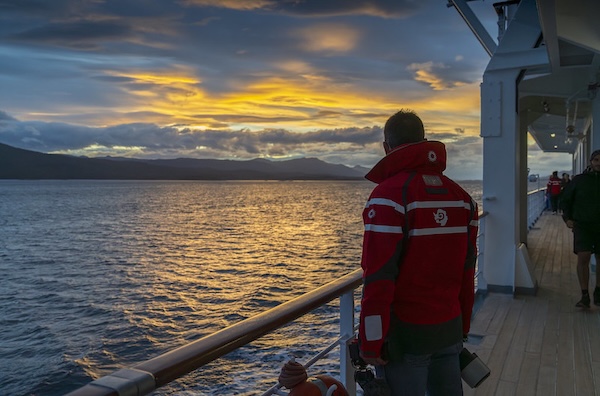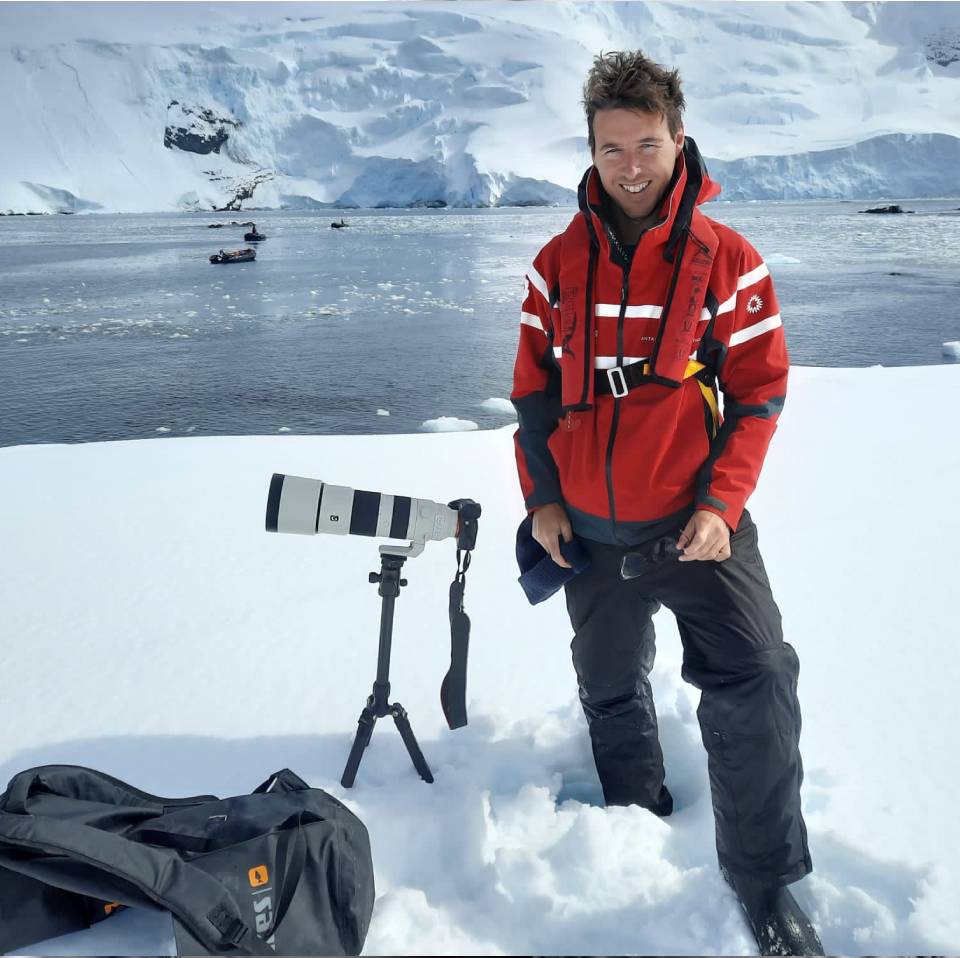The Beagle Channel is a breathtaking waterway that offers a spectacular introduction to the wild and rugged landscapes of the Southern Hemisphere.
I personally love the Beagle Channel. Generally speaking, most cruise ships depart Ushuaia around 6pm or 7pm which gives guests an incredible sunset cruise down the Beagle.
Some of my favorite photos I’ve taken down south have been in the Beagle Channel. The clouds, the atmosphere, and the sheer excitement of heading to Antarctica, makes it a wonderful experience.
Now for some facts.
Named after HMS Beagle, the ship that carried Charles Darwin on his famous voyage in the 1830s, the Beagle Channel stretches approximately 240 kilometers (150 miles) between Argentina and Chile. As you sail down the Beagle, you will notice the towering mountains that rise up on both sides. You will also notice the islands dotted everywhere. It is truly breathtaking scenery, especially at dusk.
But what exactly can you expect to see as you sail through this legendary channel?
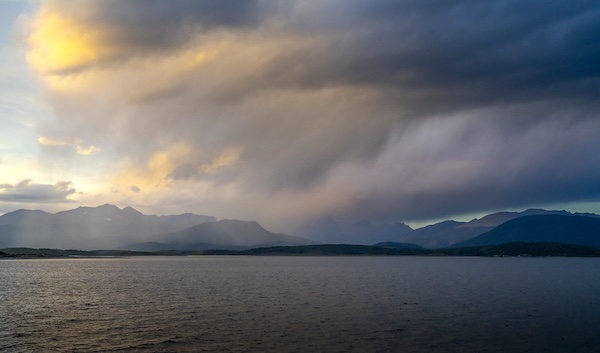
1. Ushuaia and the Surrounding Landscapes
As your ship leaves Ushuaia, you’ll be treated to stunning views of this remote city nestled between the snow-capped Martial Mountains and the Beagle Channel.
Although Ushuaia is not the prettiest of towns, the colorful buildings contrast beautifully with the surrounding wilderness.
To the north, you’ll spot the foothills of the Andes, their rugged peaks often dusted with snow, while to the south, forested islands and rocky outcrops mark the beginning of Tierra del Fuego’s wild and remote coastline.
It’s a pretty incredible view given you have only just got on your ship!
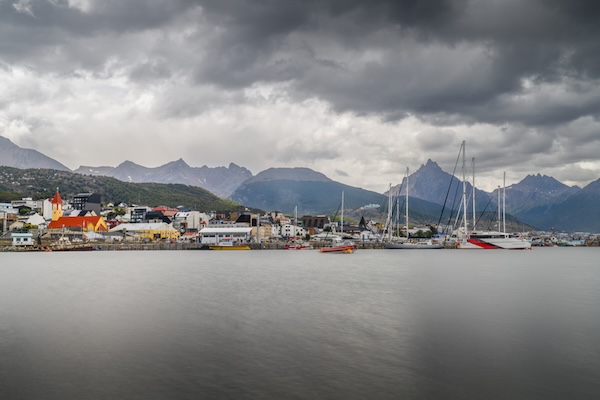
2. Les Éclaireurs Lighthouse: The “Lighthouse at the End of the World”
One of the first landmarks you'll pass is the Les Éclaireurs Lighthouse, standing proudly on a rocky islet in the channel.
Built in 1920, the lighthouse is still active today, guiding vessels safely through these remote waters.
This is a great lighthouse to photograph. But please remember to ask a member of the crew when you will be sailing past it as it is easy to miss! Hopefully you won’t be stuck doing lifeboat drills as they pass by.
The Les Éclaireurs Lighthouse is often mistakenly referred to as the “Lighthouse at the End of the World”, however, that name would more accurately belong to the San Juan de Salvamento lighthouse on Isla de los Estados.
3. Isla de Los Lobos: The Island of Sea Lions
As the ship continues eastward, it often sails past Isla de Los Lobos, or the Island of Sea Lions.
Once again, this is easy to miss, so please ask a staff member if you are unsure.
This small rocky island is home to large colonies of South American sea lions (Otaria flavescens) and South American fur seals (Arctocephalus australis).
These playful and noisy marine mammals can often be seen basking on the rocks, sparring with one another, or swimming in the frigid waters.
If you don’t see any sea lions, then don’t worry, there are usually plenty of other little rocks that you can see them on during your Beagle voyage.

4. Wildlife Watching: Albatrosses, Cormorants, dolphins and More
For me, wildlife watching is what makes the Beagle Channel truly special!
It is a haven for seabirds, dolphins and whales, making it an exciting start for wildlife lovers like myself. As you sail through the channel, keep an eye out for:
-
Black-browed albatrosses – One of the most graceful seabirds, these magnificent birds glide effortlessly on the wind.
-
Magellanic penguins - these cue penguins can often be seen porpoising near the ship.
-
Magellanic cormorants – Often seen perched on rocky outcrops, these birds resemble small penguins when they dry their wings.
-
Imperial cormorants – Distinguished by their striking black-and-white plumage and bright orange facial markings.
-
Southern giant petrels – These large seabirds often follow ships, scavenging food scraps.
-
Dolphins – Although less common, Peale’s dolphins and Commerson’s dolphins occasionally make an appearance.
-
Whales - on my last voyage we saw eight sei whales and one fin whale in the Beagle Channel.
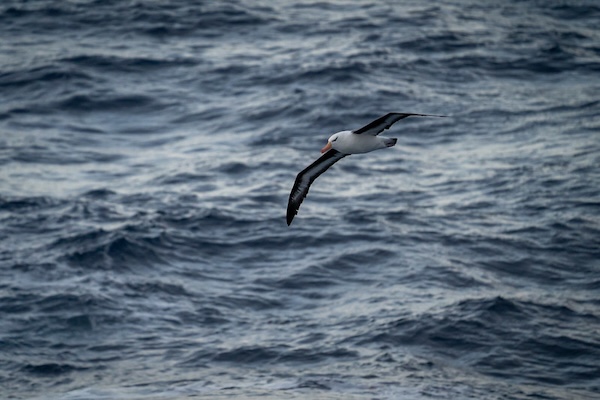
5. Isla Martillo: The Penguin Colony
About half way down the Beagle you will see Isla Martillo.
This tiny island is home to a colony of Magellanic penguins, which arrive here to breed during the austral summer (October to March).
Although you may not see the penguins from the ship, you will have an excellent chance of seeing them porpoising near the ship.
If you’re lucky, you might also spot gentoo penguins, which have recently started nesting on the island.
Occasionally, a few king penguins—usually found much further south—are spotted among the colony, but don’t hold your breath!
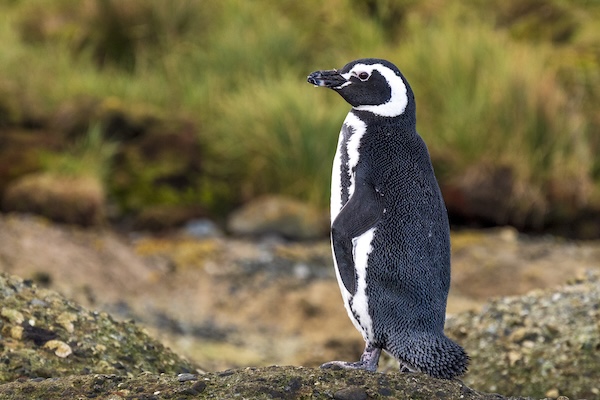
6. The Glaciers of the Beagle Channel
One of the most breathtaking sights in the Beagle Channel is the glacier-lined fjords that extend from the Darwin Range in Chile.
The most famous glaciers in this area include:
- España Glacier
- Romanche Glacier
- Germany Glacier
- Holland Glacier
- Italia Glacier
These ancient ice formations, many of which are thousands of years old, glow with striking shades of blue and white.
Seeing these glaciers is a reminder of the power of nature and the vast, untouched wilderness that lies ahead. I f you are a glacier fan and want to explore them more, there are several ‘Chilean Fjords’ cruises that do just that.
7. The History and Indigenous Legacy of the Beagle Channel
Beyond its natural beauty, the Beagle Channel is steeped in history. The channel was home to the Yaghan (Yámana) people, an Indigenous group who lived in these harsh conditions for thousands of years, surviving primarily on fishing and gathering shellfish.
The one fact that I always find incredible about the Yaghan people is that they used to live almost completely naked, even during winter!
They were so well-adapted to their climate that they did not even need clothes. Charles Darwin documented his encounters with the Yaghan people, noting their resilience and ability to thrive in such an extreme environment.
Unfortunately, European colonization and diseases devastated their population, and only a small number of Yaghan descendants remain today.
Today, the Beagle Channel serves as a vital passage for ships bound for Antarctica, continuing its legacy as a place of exploration and adventure.
- Leaving the Beagle Channel and Entering the Drake Passage
As your ship reaches the eastern end of the Beagle Channel, you’ll sail past Navarino Island (Chile) and head toward the open waters of the Drake Passage.
This marks the transition from the relatively sheltered waters of the channel to the vast and unpredictable Southern Ocean.
If it is a clear day, you may even be able to see the infamous Cape Horn off to your right.
At this point, many travelers brace themselves for what’s ahead—either the “Drake Shake” (rough seas) or the “Drake Lake” (calm waters).
But regardless of what the Drake Passage has in store, the Beagle Channel provides a spectacular and memorable start to your Antarctic adventure.
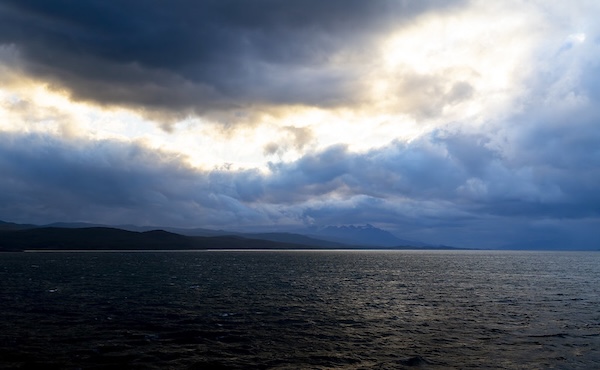
Final Thoughts
Sailing through the Beagle Channel is something I always look forward to - it’s an experience in itself!
From the rugged landscapes of Tierra del Fuego to the incredible wildlife encounters, every moment spent in these waters is a reminder of the raw, untamed beauty of the far south.
If you’re lucky enough to get an amazing sunset, then you’re going to have one of the most amazing evenings on deck.
My advice is to breathe in the crisp air and watch the seabirds soar overhead, take a moment to appreciate this incredible place. It’s the beginning of an unforgettable journey to the White Continent.

